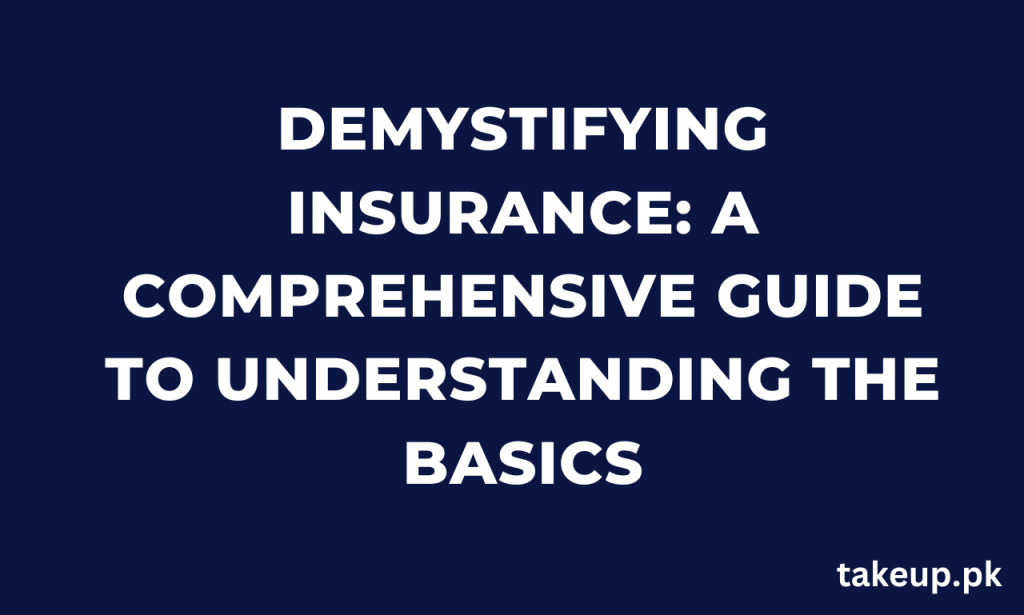Insurance is a critical aspect of our modern lives, providing protection against unexpected events and mitigating financial risks. However, many people find insurance confusing and overwhelming due to its complex terminology, various types, and intricate processes. In this comprehensive guide, we will break down the basics of insurance, demystify the jargon, and help you understand how insurance works, so you can make informed decisions when it comes to protecting yourself, your loved ones, and your assets.
What is Insurance?
At its core, insurance is a contract between an individual or entity (the policyholder) and an insurance company (the insurer) in which the policyholder pays a premium in exchange for the insurer’s promise to provide financial protection in the event of a covered loss or damage. Insurance is designed to transfer the risk of potential losses from the policyholder to the insurer, providing a safety net and financial peace of mind.
The concept of insurance dates back to ancient times when traders sought protection against the loss of goods due to theft or natural disasters. Over the centuries, insurance has evolved into a sophisticated industry with various types of insurance products that cater to different needs and risks. Let’s take a closer look at the main components of insurance:
Components of insurance
Premium: This is the amount the policyholder pays to the insurer in exchange for insurance coverage. The premium can be a one-time payment or paid in installments, typically monthly, quarterly, or annually. The amount of the premium is determined by various factors, such as the type of insurance, the coverage amount, the policyholder’s risk profile, and the insurer’s underwriting guidelines.
Coverage: This refers to the specific protections provided by the insurance policy. It outlines what is covered, the limits of coverage, and any exclusions or conditions that may apply. The coverage can vary greatly depending on the type of insurance, and it’s essential to carefully review and understand the coverage details to ensure that it meets your specific needs.
Deductible: This is the amount the policyholder is responsible for paying out of pocket before the insurance coverage kicks in. For example, if you have a health insurance policy with a $1,000 deductible and you incur medical expenses of $5,000, you would need to pay the first $1,000, and the insurance would cover the remaining $4,000, subject to any other policy limits or conditions.
Policy Limit: This is the maximum amount the insurer will pay out for a covered loss or event. Policy limits can vary depending on the type of insurance and the coverage purchased. It’s important to understand the policy limits and make sure they are sufficient to protect your assets adequately.
Types of Insurance
There are numerous types of insurance available in the market, each designed to cover specific risks and provide financial protection in different areas of life. Here are some of the most common types of insurance:
- Auto Insurance: Auto insurance provides coverage for vehicles, including cars, trucks, motorcycles, and other road vehicles. It typically includes liability coverage, which pays for damages and injuries caused to others in an accident, as well as collision and comprehensive coverage, which pays for damages to the insured vehicle in the event of an accident, theft, or other covered events.
- Homeowners/Renters Insurance: Homeowners insurance provides coverage for damages to a home and its contents, as well as liability coverage for injuries that may occur on the property. Renters’ insurance provides similar coverage for tenants who rent their homes or apartments. These types of insurance can protect against damages caused by fire, theft, vandalism, and other covered events, as well as provide liability coverage in case someone is injured on the property.
- Health Insurance: Health insurance provides coverage for medical expenses, including hospitalization, surgeries, and prescription medications.doctor visits, and preventive care. Health insurance can be obtained through employers, government programs, or purchased individually. It helps to mitigate the high costs of medical care and ensures that individuals have access to necessary healthcare services.
- Life Insurance: Life insurance provides financial protection to the policyholder’s beneficiaries in the event of the policyholder’s death. It can help replace lost income, cover funeral expenses, pay off debts, and provide for the policyholder’s dependents. There are various types of life insurance, including term life insurance, which provides coverage for a specified term, and permanent life insurance, which provides coverage for the entire lifetime of the policyholder.
- Disability Insurance: Disability insurance provides income replacement in the event that the policyholder becomes disabled and is unable to work. It can help cover living expenses, medical bills, and other financial obligations during a period of disability when the policyholder is unable to earn an income.
- Liability Insurance: Liability insurance provides protection against claims or lawsuits for damages caused by the policyholder’s actions or negligence. It can be obtained by individuals or businesses and helps protect against financial loss in case of legal liabilities, such as property damage, bodily injury, or defamation.
- Business Insurance: Business insurance provides coverage for businesses against various risks, such as property damage, liability claims, business interruption, and employee injuries. It can help protect businesses from financial losses that may arise from unexpected events and ensure the continuity of operations.
Understanding the Insurance Process
The insurance process typically involves several steps, including:
- Identifying Risks: The first step in obtaining insurance is to identify the risks that you want to protect against. This involves assessing the potential losses or damages that you may face and determining the type of insurance coverage that is appropriate for your needs.
- Choosing an Insurance Provider: Once you have identified the risks you want to protect against, you need to select an insurance provider. It’s important to research different insurance companies, and compare coverage options, premiums, deductibles, and policy limits to find the best fit for your needs.
- Applying for Insurance: To obtain insurance coverage, you need to complete an application process with the chosen insurance provider. The application will typically require information about yourself, your assets, your health, or other relevant factors, depending on the type of insurance.
- Underwriting: After you have submitted the application, the insurance provider will review it and assess the risks associated with providing coverage. This process is known as underwriting, and it helps the insurer determine the premium, coverage limits, and other terms of the policy based on the assessed risks.
- Policy Issuance: If your application is approved, the insurance provider will issue a policy, which is a legal contract that outlines the terms, conditions, coverage, and premiums of the insurance. It’s important to review the policy thoroughly to ensure that it meets your expectations and provides the coverage you need.
- Premium Payment: Once the policy is issued, you will be required to pay the premium as agreed upon in the policy. Failure to pay premiums may result in the policy being canceled or coverage being terminated.
- Filing a Claim: In the event of a covered loss or damage, you need to file a claim with the insurance provider. This typically involves providing documentation of the loss or damage, such as receipts, photos, or medical records, and working with the insurer to assess the damages and process the claim.
- Claim Settlement: If the claim is approved, the insurance provider will pay out the claim amount based on the coverage and policy limits. If the claim is denied, the insurer will provide reasons for the denial, and you may have the option to appeal or seek further resolution.
Key Insurance Terminology
Understanding the terminology used in insurance is essential to make informed decisions and navigating the insurance process effectively. Here are some key insurance terms that you should be familiar with:
- Premium: The premium is the amount you pay to the insurance company for coverage. It can be paid monthly, quarterly, semi-annually, or annually, depending on the terms of your policy.
- Deductible: The deductible is the amount you must pay out of pocket before your insurance coverage kicks in. For example, if you have a $500 deductible on your auto insurance policy and you have an accident resulting in $2,000 in damages, you would need to pay the first $500, and your insurance would cover the remaining $1,500.
- Coverage Limit: The coverage limit is the maximum amount the insurance company will pay for a covered loss. It can be specified as a per-incident limit, such as $100,000 for bodily injury in an auto insurance policy, or as an aggregate limit, such as $1 million for liability coverage in a general liability insurance policy.
- Policy Exclusions: Policy exclusions are specific events or circumstances that are not covered by the insurance policy. It’s important to review the policy exclusions to understand what is not covered by your insurance, as it may affect your decision-making and expectations of coverage.
- Policy Riders: Policy riders are additional provisions or endorsements that can be added to an insurance policy to modify the coverage or terms. For example, you may add a rider to your life insurance policy to include coverage for critical illness or disability.
- Claim: A claim is a formal request to the insurance company for payment of a covered loss or damages. It involves providing documentation of the loss or damages, and the insurance company will assess the claim and determine the appropriate payout based on the coverage and policy terms.
- Co-pay: A co-pay is a fixed amount that you must pay out of pocket for each covered service or visit, typically used in health insurance. For example, you may have a $20 co-pay for each doctor visit, and the insurance company will cover the remaining costs.
- Co-insurance: Co-insurance is the percentage of the covered expenses that you are responsible for paying after meeting your deductible. For example, if you have a 20% co-insurance on a $1,000 medical bill, you would pay $200, and the insurance company would cover the remaining $800.
- Grace Period: The grace period is the specified period of time after the premium due date during which you can still make a payment without losing coverage. If you fail to make the payment within the grace period, your policy may be canceled or coverage may be terminated.
- Underwriting: Underwriting is the process that insurance companies use to assess the risks associated with providing coverage and determine the premiums, coverage limits, and other terms of the policy. It involves evaluating factors such as your age, health, occupation, and lifestyle to determine the level of risk you pose to the insurer.
Conclusion
Insurance can be complex and confusing, but understanding the basics is crucial for making informed decisions and protecting yourself, your loved ones, and your assets from unexpected risks. By familiarizing yourself with the different types of insurance, the insurance process, and key insurance terminology, you can gain a comprehensive understanding of insurance and make informed choices when selecting coverage. It’s important to review your insurance policies regularly, update them as needed, and consult with a qualified insurance professional to ensure that you have adequate coverage for your unique needs and circumstances. Remember, insurance is not a one-size-fits-all solution, and it’s important to tailor your coverage to your specific situation to ensure maximum protection.









